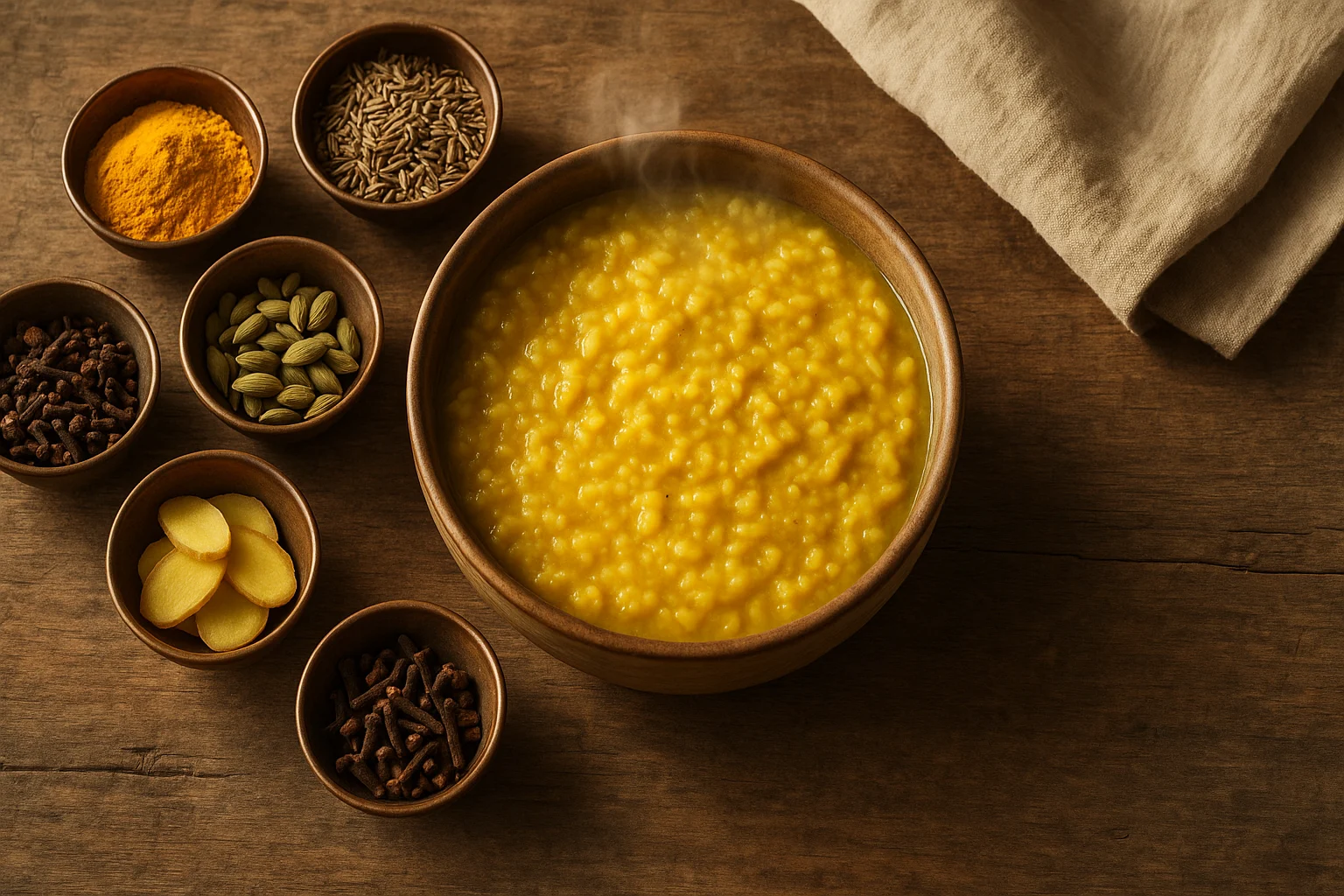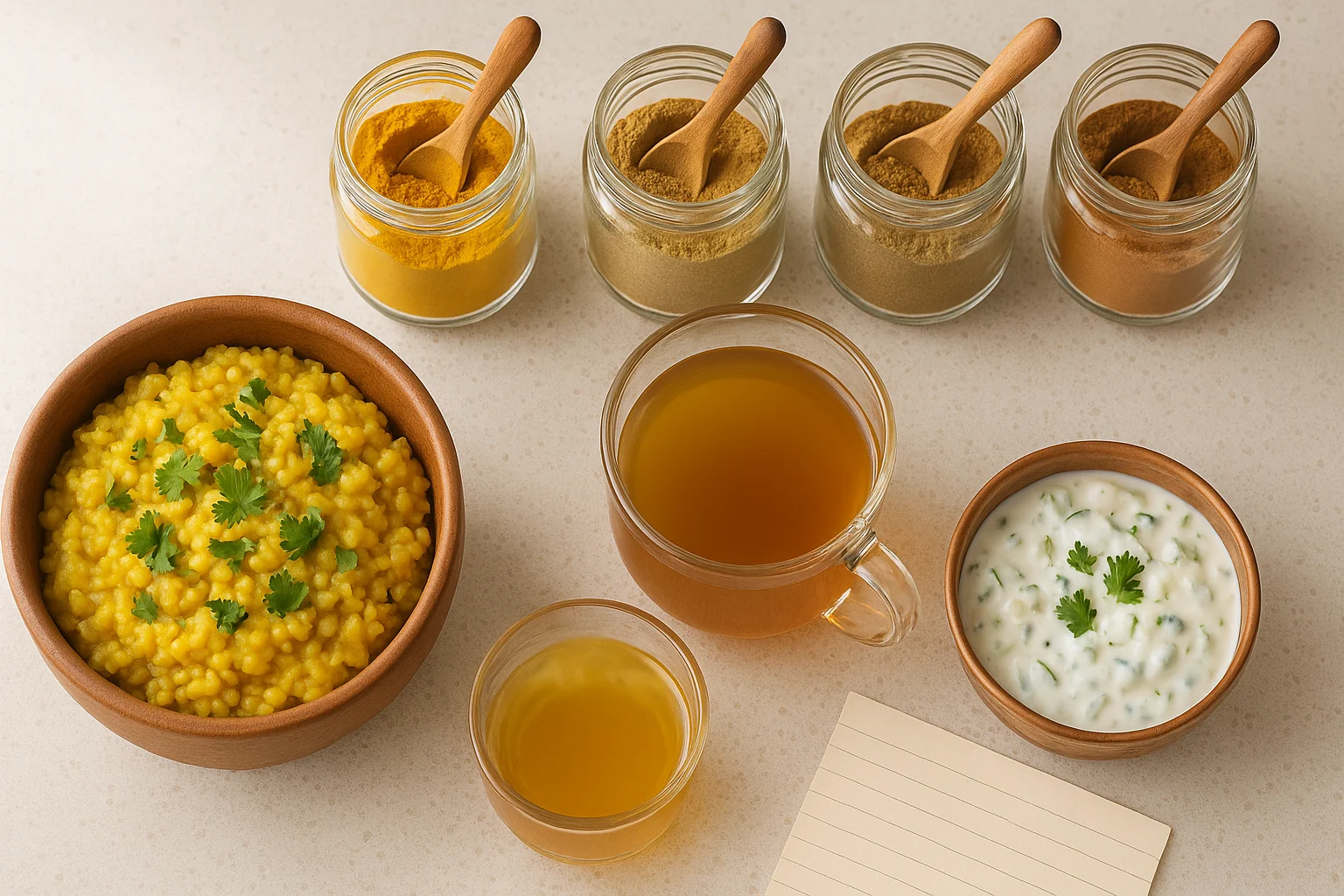
Struggling with low energy or digestion issues? This guide to ayurvedic cooking for beginners and simple daily rituals may help you feel lighter, more energized, and more balanced. To explore how these practices fit into a broader Ayurvedic approach to well-being and daily life, check out our ayurvedic wellness guide.
Start Your Ayurvedic Journey!Table of Contents
- Key Takeaways: Ayurvedic Cooking for Beginners
- Ayurvedic Cooking for Beginners: Core Principles
- Morning Rituals for a Balanced Day
- Recipe Ideas for Beginners (Ayurveda)
- Afternoon Recharge and Evening Wind-Down
- Seasonal Adjustments (Ritucharya)
- Personalize Your Ayurvedic Routine
- FAQs: Getting Started with Ayurveda Cooking
- Conclusion: Your Ayurvedic Journey Begins
Key Takeaways: Ayurvedic Cooking for Beginners
- Start simple: try warm water when you wake up and eat without distractions—even if Ayurveda is new to you.
- Embrace dinacharya: a steady daily rhythm helps you sync with nature and often brings steadier energy and a clearer mind.
- Prioritize Digestion (Agni): Beginner Ayurveda cooking supports your “digestive fire” (Agni) with warm, fresh, spiced meals.
- Beginner-Friendly Cooking: Learn easy Ayurvedic recipes using basic kitchen staples tailored to your dosha (body type).
- Mindful Living: Ayurveda goes beyond food, encouraging morning rituals, proper meal timing, and evening practices for holistic well-being.
Ayurveda Glossary
- Agni: Your digestive fire, a central concept in how the body processes food and nutrients.
- Dosha: In Ayurveda, doshas describe your general mind–body tendencies that can influence mood, digestion, and energy.
- Dinacharya: Daily routine to align with natural cycles.
- Ritucharya: Seasonal adjustments to your routine and diet.
Ayurvedic Cooking for Beginners: Core Principles
Before we get into the day-to-day, a quick stop at the basics: a few core ideas in Ayurveda that shape how you cook and plan your routine. These ideas come from a long tradition in India and act as simple guideposts for balance in everyday life. For an evidence-based overview, see the NIH’s NCCIH fact sheet on Ayurvedic medicine.
What Are Doshas?
In Ayurveda, doshas describe your general mind–body tendencies. They can influence things like mood, digestion, and energy:
- Vata (Air & Ether): Often creative and quick-moving; when out of balance you might feel anxious or dry.
- Pitta (Fire & Water): Driven and intelligent but susceptible to irritation or heat.
- Kapha (Earth & Water): Calm and steady but may experience sluggishness or congestion.
While knowing your dosha refines your routine, many practices benefit everyone, so you can start right away!
Why Agni Matters
Agni, your digestive “fire,” is a central concept in Ayurveda. Many people notice that when digestion feels strong, energy and clarity follow; when digestion feels sluggish, bloating or fatigue can show up. Ayurvedic cooking for beginners focuses on supporting Agni with warm, spiced foods. Early research suggests mindful eating may support digestion.
Dinacharya and Ritucharya
Dinacharya is the daily routine aligning you with nature’s cycles. Ritucharya is the seasonal tune-up—small shifts as the weather changes. Used together, they can support steadier balance over time.
Morning Rituals for a Balanced Day
Mornings set the tone. A short, gentle routine can calm your system and ease you into the day.
Wake Up with the Sun 🌅
Rise before or around sunrise (6:00–7:00 AM) when Vata energy is light and refreshing. This habit syncs your sleep-wake cycle with nature, supporting energy and clarity.
Why it may help: Early rising can reduce grogginess and enhance mental focus.
Tongue Scraping (Jihwa Prakshalana) 👅
Gently scrape your tongue 7–10 times with a stainless steel or copper scraper to remove tongue buildup (traditionally described as ama) accumulated overnight. This practice can leave you feeling fresher.
Why it may help: May reduce oral bacteria, freshen breath, support taste, and gently stimulate digestion.
How-to:
- Purchase a tongue scraper (available online or at health stores).
- Stand over a sink.
- Place the scraper at the back of your tongue.
- Gently pull forward with light pressure.
- Rinse the scraper after each pass.
- Repeat 5–10 times until your tongue is clean.
Warm Water & Lemon (Ushapan) 🍋
Drink a large glass of warm water, optionally with fresh lemon juice, first thing in the morning. Avoid very cold water, as it may feel heavy on digestion.
Why it may help: Hydrates, gently stimulates digestion, and supports your body’s natural elimination.
Beginner Tip: Warm water alone is powerful if lemon feels like too much!
Self-Massage (Abhyanga) 💆♀️
Before showering, massage warm sesame (Vata), coconut (Pitta), or mustard (Kapha) oil over your body using long strokes on limbs and circular motions on joints. Let it soak for 5–15 minutes.
Why it may help: May calm the nervous system, moisturize skin, and support circulation.
Beginner Tip: Start with a 5-minute foot or scalp massage if time is short.
Gentle Movement & Meditation 🧘
Next, incorporate light activity and mindfulness to energize your body and mind. To enhance relaxation, try pairing these with yoga and breathwork practices.
- Movement: Try 15–30 minutes of gentle yoga, stretching, or a brisk walk. Tailor it to your dosha:
- Vata: Gentle yoga, walking.
- Pitta: Cooling yoga, swimming.
- Kapha: A brisk walk or a more energizing yoga flow.
- Meditation: Try 5–10 minutes of easy breathing or quiet sitting to steady your mind.

Ayurvedic Recipes for Beginners: Simple & Nourishing
If ayurvedic meal prep feels like a lot at first, start small—it’s simpler than it looks. For more on the food basics, check out our guide on Ayurvedic nutrition essentials.
If you’re looking for beginner Ayurveda cooking tips, start with simple ingredients and cook with intention rather than complexity.
This post has affiliate links. We may earn a commission. Learn more.
Why Agni Is Key in Ayurvedic Cooking
Your digestive fire (Agni) is a central Ayurvedic concept. To keep Agni feeling strong:
- Eat at regular times.
- Avoid overeating.
- Try to limit cold, raw, or very heavy foods.
- Use spices like ginger, cumin, coriander, and turmeric.
Ayurvedic Meal Prep & Timing ⏰
Eat your largest meal at midday when Agni is traditionally considered strongest:
- Breakfast (7:00–9:00 AM): Light and nourishing.
- Lunch (12:00–1:00 PM): Your main meal.
- Dinner (6:00–7:00 PM): keep it light and a bit earlier.
Basic Kitchen Staples for Ayurvedic Cooking
No need for anything fancy. A simple pantry works—start with these:
- Grains: Basmati rice, quinoa, oats.
- Legumes: Moong dal (split yellow lentils), red lentils.
- Fats: Ghee, sesame oil, coconut oil.
- Spices: Turmeric, cumin, coriander, ginger, black pepper, fennel, cardamom, cinnamon, asafoetida (hing).
- Vegetables: Seasonal, local options like root veggies and greens.
- Fruits: Seasonal choices.
- Sweeteners: Jaggery, maple syrup, dates (in moderation).
Keep your ayurvedic meal prep efficient by prepping grains, chopping vegetables, and storing homemade spice blends ahead of time. This makes weekday meals more effortless and aligned with your dosha.
Easy Recipes to Get You Started
Now let’s dive into the kitchen. Below are some easy, dosha-friendly meals you can make at home—even if you’re new to Ayurveda.
Whether you’re new or seasoned, these Ayurveda-friendly dishes can bring nourishment to your daily routine. For more beverage ideas, explore our guide to Ayurvedic teas for balance.
These dosha-friendly recipes are easy to prepare and digest—perfect for beginners to Ayurvedic cooking.
Vata-Friendly Recipes (Warming, Grounding) 🥣
Vata types often do well with warm, moist foods. Try to limit very dry or raw dishes.
- Breakfast: Warm oatmeal with almond milk, ginger, cinnamon, and cooked apples or berries. Add 1 tsp ghee.
- Lunch/Dinner: Kitchari (Moong Dal & Rice Stew):
- Sauté 1 tsp cumin seeds, a pinch of turmeric, and fresh ginger in 1 tbsp ghee.
- Add ½ cup rinsed moong dal and ¼ cup rinsed basmati rice.
- Pour in 4–5 cups water, boil, then simmer for 20–30 minutes.
- Add chopped carrots or zucchini in the last 10 minutes.
- Serve warm.
- Snack: Warm vegetable soup, baked sweet potato, or soaked almonds.
- Extra Recipe: Spiced Ginger Tea:
- Boil 1 cup water with ½ tsp grated fresh ginger and a pinch of cinnamon.
- Simmer 5 minutes, strain, and sip warm.
Pitta-Friendly Recipes (Cooling, Mild) 🥗
Pitta types often benefit from cooling, sweet, or bitter foods. Try to limit very spicy or oily dishes.
- Breakfast: Oatmeal with blueberries or pears, or a smoothie with coconut milk, banana, and cilantro.
- Lunch/Dinner: Cooling Veggie Bowl:
- Cook quinoa or basmati rice.
- Sauté zucchini, green beans, and greens in coconut oil with coriander and fennel.
- Combine with rice, add a splash of lime juice or cilantro.
- Snack: Sliced cucumber, sweet grapes, or pumpkin seeds.
- Extra Recipe: Cucumber Raita:
- Mix ½ cup plain yogurt with ½ cup diced cucumber and 1 tsp chopped mint.
- Add a pinch of cumin and salt. Serve chilled.
Kapha-Friendly Recipes (Light, Stimulating) 🌶️
Kapha types often prefer light, warm, and gently spicy foods. Try to limit heavy or very sweet dishes.
- Breakfast: Lightly cooked barley porridge with ginger and cinnamon, no sugar.
- Lunch/Dinner: Spicy Lentil Soup:
- Cook ½ cup red lentils in 4 cups water.
- Sauté mustard seeds, asafoetida, ginger, and green chilies in 1 tsp ghee.
- Add spices to lentils, serve with steamed broccoli.
- Snack: Dry-roasted pumpkin seeds, a small apple, or ginger tea.
- Extra Recipe: Ginger Barley Soup:
- Cook ¼ cup barley in 4 cups water.
- Sauté 1 tsp grated ginger and a pinch of black pepper in 1 tsp ghee.
- Add to barley with chopped spinach, simmer 5 minutes.

Sample One-Day Meal Plans for Each Dosha
Here’s a simple daily menu to guide beginners to Ayurvedic cooking:
| Dosha | Breakfast | Lunch | Dinner |
|---|---|---|---|
| Vata | Oatmeal with ghee, cinnamon | Kitchari with carrots | Vegetable soup with rice |
| Pitta | Coconut milk smoothie | Quinoa veggie bowl | Steamed greens with rice |
| Kapha | Spiced cooked apple | Red lentil soup | Ginger barley soup |
Mindful Eating Practices 🧘♀️
How you eat matters as much as what you eat. For best results:
- Eat in a calm, distraction-free environment.
- Chew slowly to aid digestion.
- Eat until satisfied, not stuffed (leave ⅓ of your stomach empty).
- Sit down to eat, avoiding meals on the go.
- Sip warm water during meals, not cold drinks.
Simple habits like these can make Ayurvedic cooking more intentional and nourishing with every bite.
Afternoon Recharge and Evening Wind-Down
Later in the day, aim for steady energy without over-stimulating. These Ayurvedic afternoon and evening habits can support calm, digestion, and sleep.
Afternoon Refresh (2:00–6:00 PM) ☕
Try these to keep energy steady:
- Light Snack: Choose fruit or nuts if hungry. Try to avoid heavy, processed snacks.
- Herbal Tea: Sip ginger, fennel, or peppermint tea to support Agni.
- Short Walk: A 10–15 minute walk can boost energy and support digestion.
Light Dinner for Better Sleep 🍲
As Agni is considered gentler in the evening, eat a light dinner by 7:00 PM, 2–3 hours before bed. Opt for vegetable soup, kitchari, or steamed veggies with a small grain portion. Try to limit heavy meats or large raw salads at night.
Evening Rituals for Restful Sleep 😴
Wind down effectively to promote deep rest:
- Oil Pulling (Gandusha): Swish sesame or coconut oil in your mouth for 5–10 minutes, then spit and rinse.
- Warm Milk (Optional): A cup of warm milk (dairy or non-dairy) with nutmeg or cardamom may help calm Vata types.
- Wind-Down Activities:
- Aim to pause screens an hour before bed.
- Read a calming book or take a warm bath.
- Practice gentle stretching or listen to soothing music.
- Early Bedtime: Aim for bedtime by about 10:00 PM for restorative sleep.
Seasonal Adjustments (Ritucharya)
Adapt your routine and beginner Ayurvedic cooking to the seasons:
- Spring (Kapha): Eat lighter, bitter foods like greens and cleansing teas. Increase activity to counter sluggishness.
- Summer (Pitta): Choose cooling, mild foods like fruits and salads. Avoid midday heat.
- Autumn/Winter (Vata): Prioritize warm, nourishing foods like stews and root vegetables with warming spices.
Personalize Your Ayurvedic Routine
This tool helps you create a personalized Ayurvedic routine based on your time of day and dosha. Click the buttons below to see tailored suggestions.
Ayurvedic Routine Builder
Click a time of day and dosha to get personalized ritual recommendations.
Your Suggested Rituals 🌿
💡 Try one new ritual for a week before adding another so you can feel what truly supports you.
FAQs: Getting Started with Ayurveda Cooking
Conclusion: Your Ayurvedic Journey Begins
When I first tried beginner Ayurvedic cooking, a simple kitchari recipe helped me notice less bloating over time. This journey is about consistency, not perfection. By adding a few rituals and easy Ayurvedic meals, you may notice steadier energy, gentler digestion, and more balance. Start small, listen to your body, and let the practice meet you where you are.


